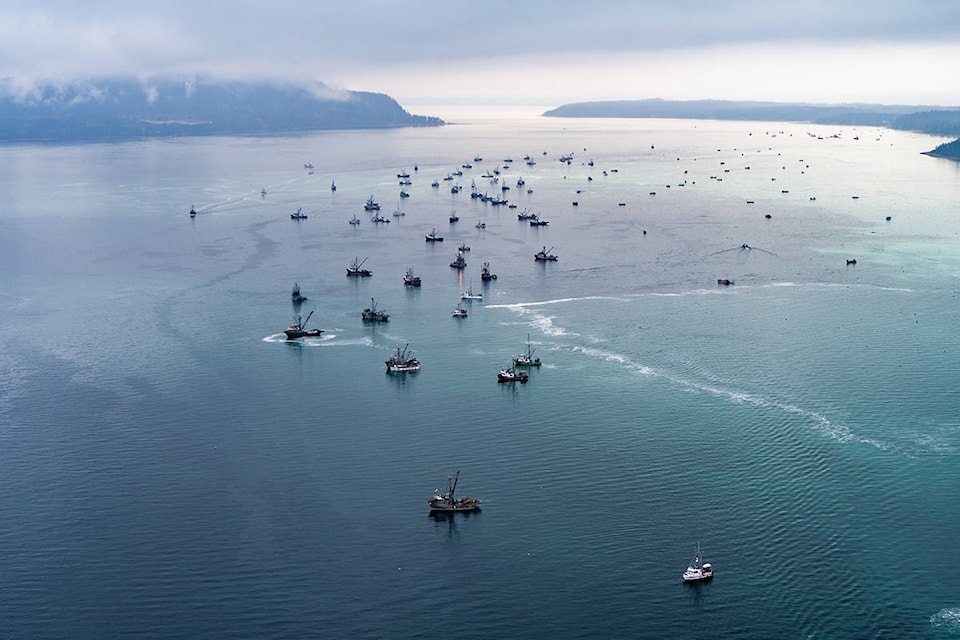A Fisheries and Oceans Canada (DFO) management plan for herring recommends a 20 per cent harvest in the Strait of Georgia. Opponents say the harvest rate has contributed to a 60 per cent decline in the population size since 2016.
The roe fishery is slated to open early March, pending approval of the Integrated Fisheries Management Plans from the director general of the Pacific Region.
Conservancy Hornby Island to suspend the Pacific herring roe fishery. As of Tuesday, it was closing in on 114,000 signatures. The goal is 150,000. Courtenay-Alberni MP Gord Johns has also launched an e-petition to suspend industrial herring fishing in the Strait of Georgia. For every 25 signatures, he “will be able to stand up and challenge Bernadette Jordan, the new Minister for Fisheries and Oceans Canada, on the mismanagement of herring on this coast,” the petition states.
The petition says DFO announced last October that the herring population has dwindled from about 129,500 metric tonnes in 2016 to 85,700 tonnes in 2019, and is predicted to fall to 54,242 tonnes in 2020. The petition also claims the herring fishery is worth little money and produces few jobs.
Ian McAllister, executive director at Pacific Wild, says DFO’s refusal to protect remaining herring stocks undermines its conservation mandate.
“There’s no real good story to be told on the herring fishery,” he said. “That’s what makes it almost incomprehensible that DFO is continuing to manage these stocks the same way they’ve managed all the other stocks on the B.C. coast that have resulted in collapse and total shutdown of the commercial fisheries.”
Despite a projected 61 per cent decline in herring biomass this year, he said DFO continues to allocate 20 per cent of the biomass of Strait of Georgia herring.
“There’s huge concerns for herring, and DFO just has its head in the sand on this issue,” McAllister said. “Not willing to listen to all of the independent research, concerns of the B.C. citizenry…It should be shut down just based on the fact that the majority of chinook salmon diet is Pacific herring.”
He said the “low value fishery” is only worth about $9 million.
Phil Young of the Canadian Fishing Company (Canfisco) says the herring fishery has been worth about $50 million, spread between vessels, crews, processing plants and sales.
“The fishermen nowadays, with just salmon and herring on seine boats, it is important. It does generate some income,” said Young, Canfisco’s vice-president of fisheries and corporate affairs. “A lot of our plants aren’t going much this time of year.”
He notes that herring provides food for chinook salmon when they’re older.
RELATED: The two sides of the herring fishery
“But some of the highest abundance of herring in the Gulf have been recently, and yet the chinook hasn’t done as well. And periods where there was less herring in the 70s and 80s, is when the chinooks did really well. So it’s obviously a lot more than just the herring.
“The harvest rate of 20 per cent is 20 per cent of the observed biomass of more than two years old,” he added. “So any herring under two years old, they don’t count. It’s of the spawning biomass, which is when they become three.”
Young notes that DFO is not counting herring in minor areas of the Gulf of Georgia.
“If you just look at the science and take the other factors out of there, we could be fishing in those areas (west and central coast) as well,” Young said. “The 20 per cent is conservative. It’s got an up or down variance. We fished within that model still.”
The IFMP is up for approval following a 30-day public consultation period, which is open until Friday, Jan. 17. Comments may be provided in writing to Victoria Postlethwaite, Regional Herring Officer, at Victoria.Postlethwaite@dfo-mpo.gc.ca.
reporter@comoxvalleyrecord.com
Like us on and follow us on



